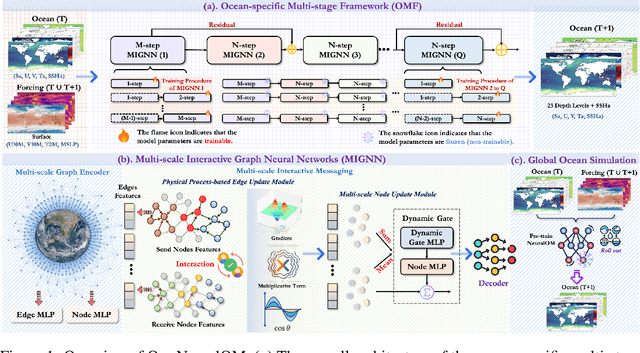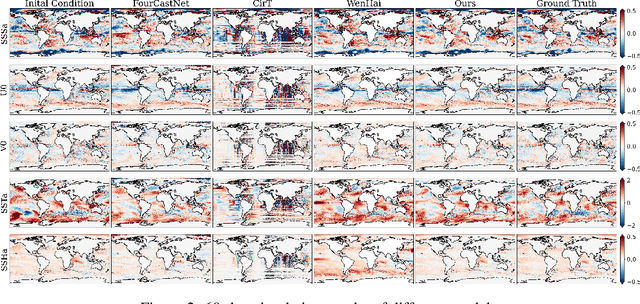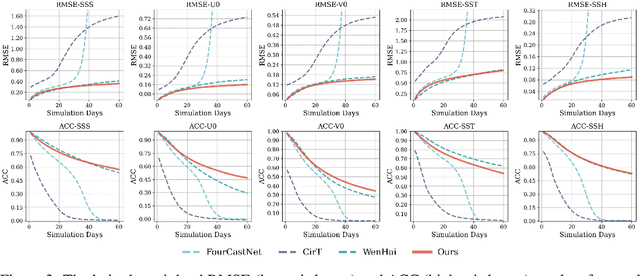Qingsong Wen
The Procrustean Bed of Time Series: The Optimization Bias of Point-wise Loss
Dec 21, 2025Abstract:Optimizing time series models via point-wise loss functions (e.g., MSE) relying on a flawed point-wise independent and identically distributed (i.i.d.) assumption that disregards the causal temporal structure, an issue with growing awareness yet lacking formal theoretical grounding. Focusing on the core independence issue under covariance stationarity, this paper aims to provide a first-principles analysis of the Expectation of Optimization Bias (EOB), formalizing it information-theoretically as the discrepancy between the true joint distribution and its flawed i.i.d. counterpart. Our analysis reveals a fundamental paradigm paradox: the more deterministic and structured the time series, the more severe the bias by point-wise loss function. We derive the first closed-form quantification for the non-deterministic EOB across linear and non-linear systems, and prove EOB is an intrinsic data property, governed exclusively by sequence length and our proposed Structural Signal-to-Noise Ratio (SSNR). This theoretical diagnosis motivates our principled debiasing program that eliminates the bias through sequence length reduction and structural orthogonalization. We present a concrete solution that simultaneously achieves both principles via DFT or DWT. Furthermore, a novel harmonized $\ell_p$ norm framework is proposed to rectify gradient pathologies of high-variance series. Extensive experiments validate EOB Theory's generality and the superior performance of debiasing program.
CaPulse: Detecting Anomalies by Tuning in to the Causal Rhythms of Time Series
Aug 06, 2025



Abstract:Time series anomaly detection has garnered considerable attention across diverse domains. While existing methods often fail to capture the underlying mechanisms behind anomaly generation in time series data. In addition, time series anomaly detection often faces several data-related inherent challenges, i.e., label scarcity, data imbalance, and complex multi-periodicity. In this paper, we leverage causal tools and introduce a new causality-based framework, CaPulse, which tunes in to the underlying causal pulse of time series data to effectively detect anomalies. Concretely, we begin by building a structural causal model to decipher the generation processes behind anomalies. To tackle the challenges posed by the data, we propose Periodical Normalizing Flows with a novel mask mechanism and carefully designed periodical learners, creating a periodicity-aware, density-based anomaly detection approach. Extensive experiments on seven real-world datasets demonstrate that CaPulse consistently outperforms existing methods, achieving AUROC improvements of 3% to 17%, with enhanced interpretability.
From Entanglement to Alignment: Representation Space Decomposition for Unsupervised Time Series Domain Adaptation
Jul 28, 2025Abstract:Domain shift poses a fundamental challenge in time series analysis, where models trained on source domain often fail dramatically when applied in target domain with different yet similar distributions. While current unsupervised domain adaptation (UDA) methods attempt to align cross-domain feature distributions, they typically treat features as indivisible entities, ignoring their intrinsic compositions that governs domain adaptation. We introduce DARSD, a novel UDA framework with theoretical explainability that explicitly realizes UDA tasks from the perspective of representation space decomposition. Our core insight is that effective domain adaptation requires not just alignment, but principled disentanglement of transferable knowledge from mixed representations. DARSD consists three synergistic components: (I) An adversarial learnable common invariant basis that projects original features into a domain-invariant subspace while preserving semantic content; (II) A prototypical pseudo-labeling mechanism that dynamically separates target features based on confidence, hindering error accumulation; (III) A hybrid contrastive optimization strategy that simultaneously enforces feature clustering and consistency while mitigating emerging distribution gaps. Comprehensive experiments conducted on four benchmark datasets (WISDM, HAR, HHAR, and MFD) demonstrate DARSD's superiority against 12 UDA algorithms, achieving optimal performance in 35 out of 53 cross-domain scenarios.
Cross-Domain Conditional Diffusion Models for Time Series Imputation
Jun 14, 2025Abstract:Cross-domain time series imputation is an underexplored data-centric research task that presents significant challenges, particularly when the target domain suffers from high missing rates and domain shifts in temporal dynamics. Existing time series imputation approaches primarily focus on the single-domain setting, which cannot effectively adapt to a new domain with domain shifts. Meanwhile, conventional domain adaptation techniques struggle with data incompleteness, as they typically assume the data from both source and target domains are fully observed to enable adaptation. For the problem of cross-domain time series imputation, missing values introduce high uncertainty that hinders distribution alignment, making existing adaptation strategies ineffective. Specifically, our proposed solution tackles this problem from three perspectives: (i) Data: We introduce a frequency-based time series interpolation strategy that integrates shared spectral components from both domains while retaining domain-specific temporal structures, constructing informative priors for imputation. (ii) Model: We design a diffusion-based imputation model that effectively learns domain-shared representations and captures domain-specific temporal dependencies with dedicated denoising networks. (iii) Algorithm: We further propose a cross-domain consistency alignment strategy that selectively regularizes output-level domain discrepancies, enabling effective knowledge transfer while preserving domain-specific characteristics. Extensive experiments on three real-world datasets demonstrate the superiority of our proposed approach. Our code implementation is available here.
From Images to Signals: Are Large Vision Models Useful for Time Series Analysis?
May 29, 2025Abstract:Transformer-based models have gained increasing attention in time series research, driving interest in Large Language Models (LLMs) and foundation models for time series analysis. As the field moves toward multi-modality, Large Vision Models (LVMs) are emerging as a promising direction. In the past, the effectiveness of Transformer and LLMs in time series has been debated. When it comes to LVMs, a similar question arises: are LVMs truely useful for time series analysis? To address it, we design and conduct the first principled study involving 4 LVMs, 8 imaging methods, 18 datasets and 26 baselines across both high-level (classification) and low-level (forecasting) tasks, with extensive ablation analysis. Our findings indicate LVMs are indeed useful for time series classification but face challenges in forecasting. Although effective, the contemporary best LVM forecasters are limited to specific types of LVMs and imaging methods, exhibit a bias toward forecasting periods, and have limited ability to utilize long look-back windows. We hope our findings could serve as a cornerstone for future research on LVM- and multimodal-based solutions to different time series tasks.
Topological Structure Learning Should Be A Research Priority for LLM-Based Multi-Agent Systems
May 29, 2025Abstract:Large Language Model-based Multi-Agent Systems (MASs) have emerged as a powerful paradigm for tackling complex tasks through collaborative intelligence. Nevertheless, the question of how agents should be structurally organized for optimal cooperation remains largely unexplored. In this position paper, we aim to gently redirect the focus of the MAS research community toward this critical dimension: develop topology-aware MASs for specific tasks. Specifically, the system consists of three core components - agents, communication links, and communication patterns - that collectively shape its coordination performance and efficiency. To this end, we introduce a systematic, three-stage framework: agent selection, structure profiling, and topology synthesis. Each stage would trigger new research opportunities in areas such as language models, reinforcement learning, graph learning, and generative modeling; together, they could unleash the full potential of MASs in complicated real-world applications. Then, we discuss the potential challenges and opportunities in the evaluation of multiple systems. We hope our perspective and framework can offer critical new insights in the era of agentic AI.
NeuralOM: Neural Ocean Model for Subseasonal-to-Seasonal Simulation
May 27, 2025



Abstract:Accurate Subseasonal-to-Seasonal (S2S) ocean simulation is critically important for marine research, yet remains challenging due to its substantial thermal inertia and extended time delay. Machine learning (ML)-based models have demonstrated significant advancements in simulation accuracy and computational efficiency compared to traditional numerical methods. Nevertheless, a significant limitation of current ML models for S2S ocean simulation is their inadequate incorporation of physical consistency and the slow-changing properties of the ocean system. In this work, we propose a neural ocean model (NeuralOM) for S2S ocean simulation with a multi-scale interactive graph neural network to emulate diverse physical phenomena associated with ocean systems effectively. Specifically, we propose a multi-stage framework tailored to model the ocean's slowly changing nature. Additionally, we introduce a multi-scale interactive messaging module to capture complex dynamical behaviors, such as gradient changes and multiplicative coupling relationships inherent in ocean dynamics. Extensive experimental evaluations confirm that our proposed NeuralOM outperforms state-of-the-art models in S2S and extreme event simulation. The codes are available at https://github.com/YuanGao-YG/NeuralOM.
Advanced long-term earth system forecasting by learning the small-scale nature
May 26, 2025Abstract:Reliable long-term forecast of Earth system dynamics is heavily hampered by instabilities in current AI models during extended autoregressive simulations. These failures often originate from inherent spectral bias, leading to inadequate representation of critical high-frequency, small-scale processes and subsequent uncontrolled error amplification. We present Triton, an AI framework designed to address this fundamental challenge. Inspired by increasing grids to explicitly resolve small scales in numerical models, Triton employs a hierarchical architecture processing information across multiple resolutions to mitigate spectral bias and explicitly model cross-scale dynamics. We demonstrate Triton's superior performance on challenging forecast tasks, achieving stable year-long global temperature forecasts, skillful Kuroshio eddy predictions till 120 days, and high-fidelity turbulence simulations preserving fine-scale structures all without external forcing, with significantly surpassing baseline AI models in long-term stability and accuracy. By effectively suppressing high-frequency error accumulation, Triton offers a promising pathway towards trustworthy AI-driven simulation for climate and earth system science.
The Eye of Sherlock Holmes: Uncovering User Private Attribute Profiling via Vision-Language Model Agentic Framework
May 25, 2025



Abstract:Our research reveals a new privacy risk associated with the vision-language model (VLM) agentic framework: the ability to infer sensitive attributes (e.g., age and health information) and even abstract ones (e.g., personality and social traits) from a set of personal images, which we term "image private attribute profiling." This threat is particularly severe given that modern apps can easily access users' photo albums, and inference from image sets enables models to exploit inter-image relations for more sophisticated profiling. However, two main challenges hinder our understanding of how well VLMs can profile an individual from a few personal photos: (1) the lack of benchmark datasets with multi-image annotations for private attributes, and (2) the limited ability of current multimodal large language models (MLLMs) to infer abstract attributes from large image collections. In this work, we construct PAPI, the largest dataset for studying private attribute profiling in personal images, comprising 2,510 images from 251 individuals with 3,012 annotated privacy attributes. We also propose HolmesEye, a hybrid agentic framework that combines VLMs and LLMs to enhance privacy inference. HolmesEye uses VLMs to extract both intra-image and inter-image information and LLMs to guide the inference process as well as consolidate the results through forensic analysis, overcoming existing limitations in long-context visual reasoning. Experiments reveal that HolmesEye achieves a 10.8% improvement in average accuracy over state-of-the-art baselines and surpasses human-level performance by 15.0% in predicting abstract attributes. This work highlights the urgency of addressing privacy risks in image-based profiling and offers both a new dataset and an advanced framework to guide future research in this area.
Turb-L1: Achieving Long-term Turbulence Tracing By Tackling Spectral Bias
May 25, 2025



Abstract:Accurately predicting the long-term evolution of turbulence is crucial for advancing scientific understanding and optimizing engineering applications. However, existing deep learning methods face significant bottlenecks in long-term autoregressive prediction, which exhibit excessive smoothing and fail to accurately track complex fluid dynamics. Our extensive experimental and spectral analysis of prevailing methods provides an interpretable explanation for this shortcoming, identifying Spectral Bias as the core obstacle. Concretely, spectral bias is the inherent tendency of models to favor low-frequency, smooth features while overlooking critical high-frequency details during training, thus reducing fidelity and causing physical distortions in long-term predictions. Building on this insight, we propose Turb-L1, an innovative turbulence prediction method, which utilizes a Hierarchical Dynamics Synthesis mechanism within a multi-grid architecture to explicitly overcome spectral bias. It accurately captures cross-scale interactions and preserves the fidelity of high-frequency dynamics, enabling reliable long-term tracking of turbulence evolution. Extensive experiments on the 2D turbulence benchmark show that Turb-L1 demonstrates excellent performance: (I) In long-term predictions, it reduces Mean Squared Error (MSE) by $80.3\%$ and increases Structural Similarity (SSIM) by over $9\times$ compared to the SOTA baseline, significantly improving prediction fidelity. (II) It effectively overcomes spectral bias, accurately reproducing the full enstrophy spectrum and maintaining physical realism in high-wavenumber regions, thus avoiding the spectral distortions or spurious energy accumulation seen in other methods.
 Add to Chrome
Add to Chrome Add to Firefox
Add to Firefox Add to Edge
Add to Edge